#it’s nature at its most fearsome and awe inspiring
Explore tagged Tumblr posts
Text
since some have been connecting the entities to the wizard the witch and the wild one i’ve decided to make my own connections
the wizard sky - the eye
the witch of the worlds heart - the web
the witch of the waning moon - the dark
the witch of the wild hunt - the hunt
the witch of the wind and stars - the lonely
#the witch of the woodland green#her entity is beyond fears#it’s nature at its most fearsome and awe inspiring#eternal green#life persevering eternally#wwwo#the wizard the witch and the wild one#tma#the magnus archives#wbn#worlds beyond number#and eursulon? vibing!
14 notes
·
View notes
Text
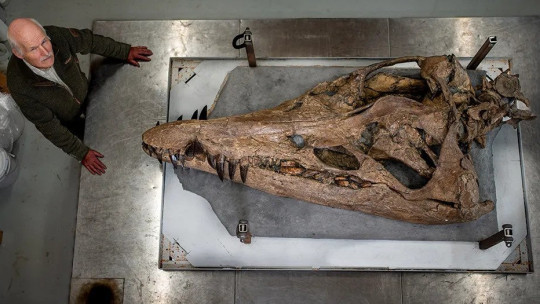
Gigantic Skull of Prehistoric Sea Monster Found on England’s ‘Jurassic Coast’
The remarkably well-preserved skull of a gigantic pliosaur, a prehistoric sea monster, has been discovered on a beach in the county of Dorset in southern England, and it could reveal secrets about these awe-inspiring creatures.
Pliosaurs dominated the oceans at a time when dinosaurs roamed the land. The unearthed fossil is about 150 million years old, almost 3 million years younger than any other pliosaur find. Researchers are analyzing the specimen to determine whether it could even be a species new to science.
Originally spotted in spring 2022, the fossil, along with its complicated excavation and ongoing scientific investigation, are now detailed in the upcoming BBC documentary “Attenborough and the Jurassic Sea Monster,” presented by legendary naturalist Sir David Attenborough, that will air February 14 on PBS.
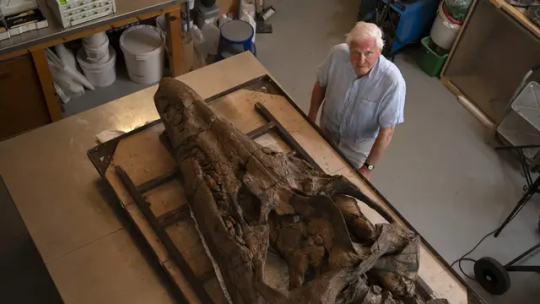
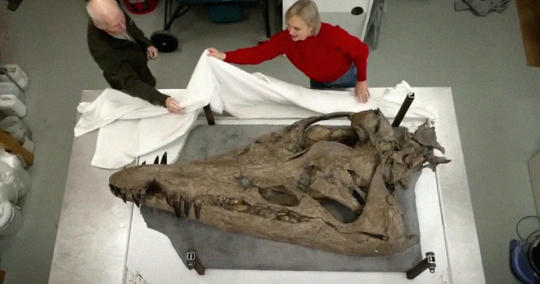
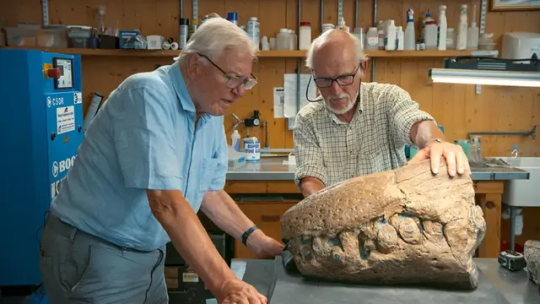
Such was the enormous size of the carnivorous marine reptile that the skull, excavated from a cliff along Dorset’s “Jurassic Coast,” is almost 2 meters (6.6 feet) long. In its fossilized form, the specimen weighs over half a metric ton. Pliosaurs species could grow to 15 meters (50 feet) in length, according to Encyclopaedia Britannica.
The fossil was buried deep in the cliff, about 11 meters (36 feet) above the ground and 15 meters (49 feet) down the cliff, local paleontologist Steve Etches, who helped uncover it, said in a video call.
Extracting it proved a perilous task, one fraught with danger as a crew raced against the clock during a window of good weather before summer storms closed in and the cliff eroded, possibly taking the rare and significant fossil with it.
Etches first learned of the fossil’s existence when his friend Philip Jacobs called him after coming across the pliosaur’s snout on the beach. Right from the start, they were “quite excited, because its jaws closed together which indicates (the fossil) is complete,” Etches said.
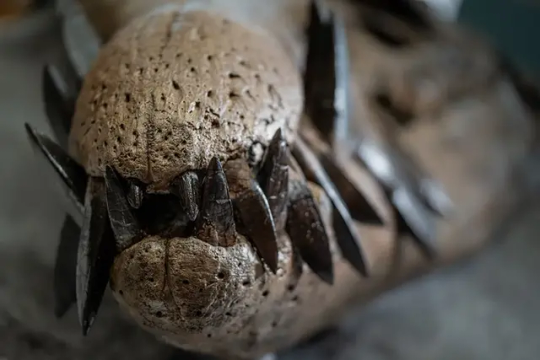
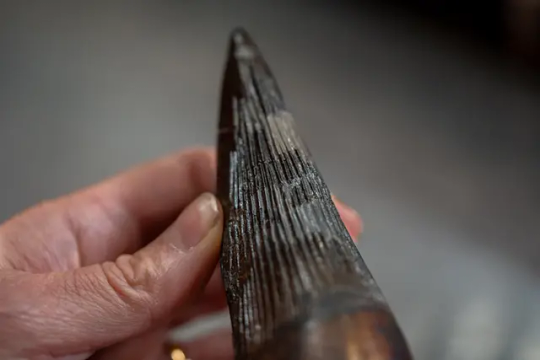
After using drones to map the cliff and identify the rest of the pliosaur’s precise position, Etches and his team embarked on a three-week operation, chiseling into the cliff while suspended in midair.
“It’s a miracle we got it out,” he said, “because we had one last day to get this thing out, which we did at 9:30 p.m.”
Etches took on the task of painstakingly restoring the skull. There was a time he found “very disillusioning” as the mud, and bone, had cracked, but “over the following days and weeks, it was a case of …, like a jigsaw, putting it all back. It took a long time but every bit of bone we got back in.”
It’s a “freak of nature” that this fossil remains in such good condition, Etches added. “It died in the right environment, there was a lot of sedimentation … so when it died and went down to the seafloor, it got buried quite quickly.”

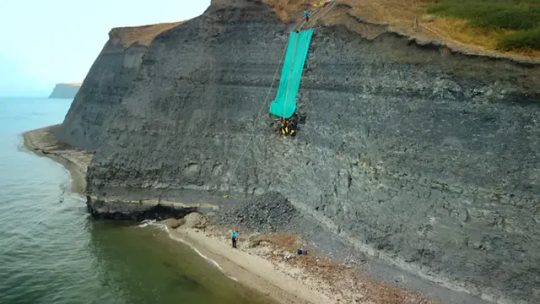
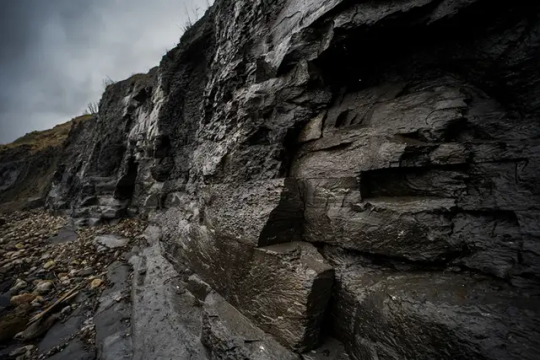
Fearsome top predator of the seas
The nearly intact fossil illuminates the characteristics that made the pliosaur a truly fearsome predator, hunting prey such as the dolphinlike ichthyosaur. The apex predator with huge razor-sharp teeth used a variety of senses, including sensory pits still visible on its skull that may have allowed it to detect changes in water pressure, according to the documentary.
The pliosaur had a bite twice as powerful as a saltwater crocodile, which has the world’s most powerful jaws today, according to Emily Rayfield, a professor of paleobiology at the University of Bristol in the United Kingdom who appeared in the documentary. The prehistoric marine predator would have been able to cut into a car, she said.
Andre Rowe, a postdoctoral research associate of paleobiology at the University of Bristol, added that “the animal would have been so massive that I think it would have been able to prey effectively on anything that was unfortunate enough to be in its space.”
By Issy Ronald.
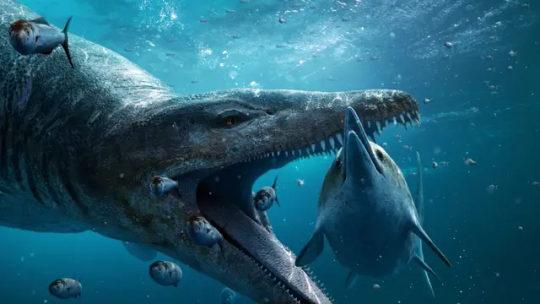
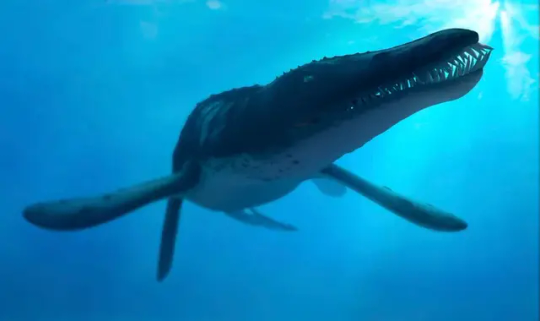
#Gigantic Skull of Prehistoric Sea Monster Found on England’s ‘Jurassic Coast’#Dorset England#pliosaur#jurassic#fossil#prehistoric#dinosaur#paleobiology#palaeontologists#archaeology#archeolgst#history#history news#ancient history#Sir David Attenborough#nature#naturalist
2K notes
·
View notes
Text
Mythology Fact #1 - Sobek, Egyptian Crocodile God
NEW SERIES! Mythology Facts will explore many elements of world mythologies, but with a particular focus on Greek, Egyptian, and Norse, especially at the start.
Easily the winner of the first poll about this new series as held on my Patreon is Sobek, the ancient Egyptian crocodile-headed god!
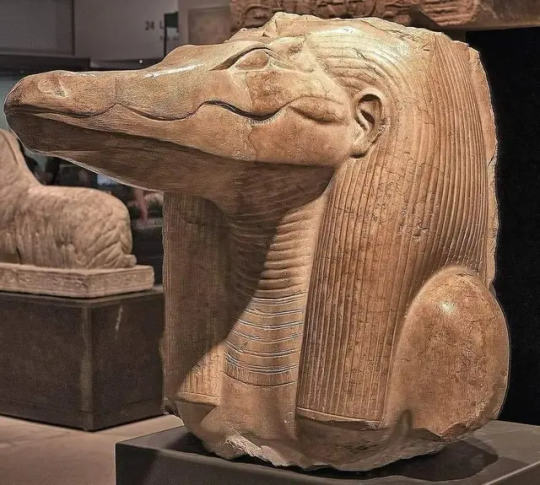
Head of a limestone statue of Sobek, as previously on display at the Met as part of a special collection; Met info on the statue head here
In ancient Egypt, like many ancient cultures, the most fearsome of beasts were highly regarded for their awe-inspiring endurance, power, and ferocity - a concept often little-understood today, as animals are now often seen as obstacles to be conquered or put out of the way, hence why it can occasionally be difficult to detail to the modern mind the relationship between men and wolves throughout history (but I'm not on that right now, so I'll stop). The people of ancient Egypt held great reverence for many animals, not least among them being the obviously very dangerous crocodile.
An integral part of life in ancient Egypt was the rise and fall of the Nile. Sobek was a centerpiece of the Nile life - crocodiles were abundant, a testament to their fertility and virility, and they were fearsome, strong, and enduring. Sobek's nature is intensely complex and his "domains," as we so often think of deities as having, were extensive, including but not limited to fertility, virility, illness, health, strength, pharonic power, military might, protection (especially protection from, essentially, bad luck), and the dangers and wonders of the Nile. By nature, he was considered animalistic, unpredictable, strong, protective but dangerous, and highly sexual, aspects frequently associated with the most powerful predators in a given region (notice all those things are also associated with wolves). Sobek was depicted variably as a crocodile and a crocodile-headed man, and holy crocodiles were kept in his name.
Given his association with the Nile and so many other things, Sobek was and mostly remained a very important figure, especially with his later fusion with/association with both Horus and Ra, two extremely important deities...
This is quite the lengthy post! More under the cut.
Among many other things, Sobek was said to have power of the fertility of the Nile's soil, as well as its waters, and thus also had great power over disease, as the Nile could also cause illnesses. Like so many ancient Egyptian deities, Sobek also had an association with the dead, being called upon to bring them sight and return their senses in the afterlife, as well as to assist in protecting them (along with many other deities, including but certainly not limited to Isis, Nephthys, and Anubis).
Sobek's strong association with fertility is found in his many epithets and even the name we use for him most - "Sobek" is thought to perhaps even come from a causative of "to impregnate" (though some scholars contend it instead means "to unite," especially in relation to the pieces of Osiris). Perhaps the first instance we have of Sobek in a text comes from the Pyramid Texts, in which a spell refers to Unis (the pharaoh) as a living incarnation of Sobek - the pharaohs were very often living incarnations of assorted deities at various times - and says that Unis "will copulate" very specifically and that he is the lord of something that would probably get this post censored, "who takes women from their husbands to the place Unis likes according to his heart's fancy."

Mummified crocodiles found in the Temple of Kom Ombo; we have found mummified crocodiles of all ages, even including fertilized eggs
Now let's talk about a thing called the petsuchos. Mummified crocodiles served as images of Sobek in various forms, one of which being Petsuchos, meaning "son of Sobek." It is thought one crocodile in particular took on the aspect of the petsuchos and was kept in Shedet, replaced by a new petsuchos whenever the previous died. Following the death of a holy crocodile, a great ritual took place to mummify the creature and then put it on display, as it remained ever sacred. Living crocodiles were sometimes kept in other temples and holy places, even including outdoor pools. They were adorned with gems and fed delicacies; some were even considered attractions, as feeding the holy crocodile brought good luck, given Sobek's apotropaic nature. There was even a divine crocodile breeding center established by Amenhotep III (who pushed the Sobek cult quite energetically).

There are many depictions of Sobek found throughout what we have of ancient Egypt, including many of its time periods. He is perhaps one of the oldest gods of ancient Egypt, having appeared as early as during the reign of King Narmer in the first dynasty. His importance during the Old Kingdom, as well, can be found in the Pyramid Texts. The entire region of Fayum was a cult center of Sobek, so great was his importance, the seat of which was - of course - the capital, Crocodilopolis or Shedet.
Also very worthy of note is Sobek-Ra, a combination of the gods Sobek and Ra, that appeared in very late-age Egypt in the New Kingdom (1150-1069 BC), and even continued into the Ptolemaic Period (around 332 BC to 390 AD). Sobek-Ra (or Sobek-Re if you want to go that way) may have first appeared during the reign of the first king of the Middle Kingdom, Montuhotep II, as addressed in the Coffin Texts used during the Middle Kingdom (in which Sobek is addressed as "he who rises in the east and sets in the west"). As a combination, depictions thereof often had the head of a falcon but the body of a crocodile, often wearing the solar disc and uraeus (cobra).
He combined aspects of both deities, which is also perhaps thanks to Sobek's association also with Horus. When Horus took on the aspect of a crocodile during his retrieval of Osiris's bodyparts, Sobek became associated with him, even considered an aspect of Horus. Likewise, however, Sobek also was said to have assisted Isis during Horus's birth. Such deity fusions, aspects, and deities becoming an aspect and/or appearing in various myths in nebulous forms were not uncommon in ancient Egypt, and Sobek was also combined with Horus at assorted other points. All of this continues to point to the association between Sobek and kings (pharaohs), especially when you reach the point of learning about Sobek of Shedet-Ra-Horus, but I won't go into all that here due to time constraints.
So, obviously, there's so much more to say that it's, frankly, crazy and almost overwhelming. The study of ancient Egypt is a complex undertaking, hence why we have an entire field called Egyptology. So, consider this very much a simplified overview. Hope you enjoyed the post!
And stay tuned for news and updates on a major [werewolf/fantasy/adventure/horror/epic] book release later this year! Likewise, if you enjoy mythology in general and Egyptian myth, be sure to check out my other works of fiction, including this one here--also available on Amazon.com and many other retailers. Sequel coming next year.
If you like my blog, be sure to follow me here and elsewhere for much more folklore and fiction, including books, especially on werewolves! You can also sign up for my free newsletter for monthly werewolf/vampire/folklore facts, a free story, book previews, and my other sundry projects and works.
Free Newsletter - maverickwerewolf.com (personal site + book shop) — Patreon — Wulfgard — Werewolf Fact Masterlist — Folklore Fact Masterlist — Mythology Fact Masterlist — X — Vampire Fact Masterlist — Amazon Author page
#mythology#myth#egyptian myth#egyptian mythology#ancient egypt#egypt#crocodile#crocodiles#the nile#nile#sobek#folklore#legend#egyptian deities#egyptian gods#mythology fact#history#egyptian history#research#fiction#Wulfgard#long post
68 notes
·
View notes
Text
The Demise of Muzan Kibutsuji: A Lego Block's Revenge
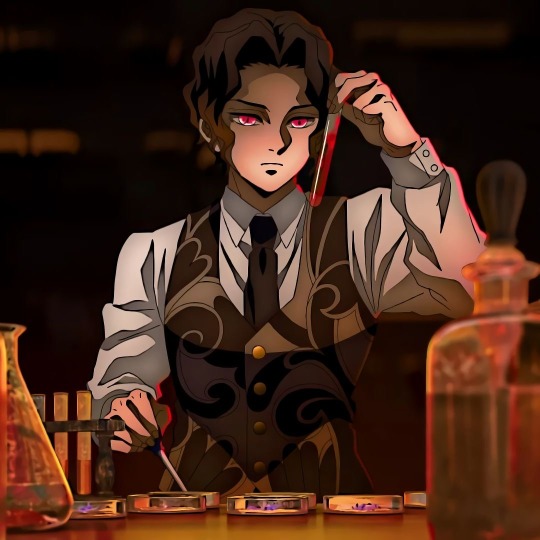

Once upon a time, in a breathtaking twist of fate within the awe-inspiring realm of "Demon Slayer," Muzan Kibutsuji, the dreaded demon lord, met a demise so shocking, so unexpected, that it sent tremors through the very fabric of his dark domain.
In the hush of the night, within the murky depths of his lair, Muzan brooded over his wicked plans, his heart filled with malice and ambition. Little did he know that a mischievous sprite had crept into his inner sanctum, leaving behind a solitary Lego block, innocuous yet sinister in its design. This seemingly harmless toy would prove to be the instrument of his undoing.
Lost in his own thoughts, Muzan prowled the chamber, his mind ablaze with treacherous plots and ruthless strategies. Oblivious to the imminent danger, he trod back, only to unwittingly crush the Lego block beneath his heel. In a sudden, searing pain that shot through his leg, Muzan staggered, he inhaled so hard that the lego block flew deep inside his throat.
The demon lord gasped in shock as he struggled for air, his unearthly powers useless against this trivial yet deadly obstruction. His loyal minions, once awed by his invincibility, now stood frozen in terror as they witnessed their mighty leader choking on a small plastic toy.
Despite his formidable might and unwavering resilience, Muzan's destiny was sealed. Each fruitless attempt to dislodge the block brought him closer to the brink of death, his once fearsome countenance growing pale in the dim light. In a final, desperate bid for survival, Muzan unleashed his demonic abilities in a futile effort to expel the accursed block, but it was too late.
With a strangled gasp, Muzan crumpled to the ground, his life slipping away before his horrified followers. The revered demon lord, whose very name had struck fear into the hearts of all, met his ignominious end not in battle against a hero or a rival, but at the cruel mercy of a humble Lego block.
The tale of Muzan Kibutsuji's downfall spread far and wide, a sobering parable of how even the most powerful beings can be brought low by the most trivial of circumstances. It stood as a grim reminder to all denizens of darkness of the fleeting nature of life, a stark reminder that even the immortal must face the inevitability of death.
#fanfic#muzan kibutsuji#demon slayer#kny#kimetsu no yaiba muzan#silly#muzan stepping on a lego block#kimetsu no yaiba
37 notes
·
View notes
Text
A Revised History of Erdas: The Four Heroes' Bond Tokens
The Four creating bond tokens of their own -- brilliant concept, terrible execution. I'll forever be disappointed in how The Dragon's Eye handled this legendary moment for our protagonists. Naturally, this is one of the first things I thought about changing in A Revised History of Erdas. So, here are my ideas!
Conor
Conor's canon bond token: Shepherd's staff of unknown origins; grants the user strengthened senses and some level of prescience.
Revised version: Conor's own shepherd's staff that he names Pathfinder, in part due to its prophetic abilities and in part as a nod to Briggan's most well-known title. This staff grants the user short prescience and increased wisdom. When wielding Pathfinder, one can predict events up to a few minutes before they happen. In time, Conor may learn to see farther into the future, but only with a level of exposure that would drive any other user insane. As for the increased wisdom, I sort of remodelled the persuasive quality of Meilin's bond token and transferred it to Conor's. These combined abilities can lend the user a great strategic advantage in battle. I scrapped the strengthened senses, which is what resulted in Conor becoming quite animalistic.
My reasoning: First of all, the object itself. I felt it would be more impactful if the staff had always been Conor's rather than a random one he picked up at the last minute. Conor is shown throughout the series to take his staff with him during the group's travels, even though it doesn't lend him much protection. It's a reminder of who he used to be -- who he still is at his core. It would have been easy to show the Oathbound confiscating the staff from him along with the rest of the team's weapons, then have Conor find it again before they create their bond tokens.
Now, onto what it does. I felt it was jarringly out of character for Conor to act like the wild, howling beast his canon bond token made him. Throughout the series, Conor has remained a levelheaded, gentle, somewhat quiet person, and even as he progresses as a character he retains these defining traits. The only time he has acted even remotely similar to how he does with his bond token is when he was possessed by the Wyrm -- which was so horrifying to read because it proved that anything left of him was well and truly gone. The fact of the matter is, the Conor at the end of The Dragon's Eye was not the Conor we knew, and that was a poor writing choice (especially for the last book of the series, where there would be no opportunity to explore this development further).
Additionally, this isn't really what we've seen of Briggan, either, and it is my goal for the Four's bond tokens to be an accurate representation of their spirit animal. In Tales of the Great Beasts, Briggan is a mystical, awe-inspiring being who is shrouded in mystery; a fearsome packleader who evokes respect and devotion and walks in dreams. That is the atmosphere I hope to emulate from Conor's bond token in ARHoE. Conor is, at his core, a wise and kindly leader who deserves to have his -- and Briggan's -- character properly emulated in their bond token. And so it will be.
Abeke
Abeke's canon bond token: Abeke's bow; grants the user increased agility and perfect shooting accuracy.
Revised version: Abeke's bow since Immortal Guardians, originally gifted to her by Lenori. She names it Swifthunter, both pointing to what it does and her and Uraza's shared natures. It grants the user the ability to conjure arrows out of nothing, perfect shooting accuracy and the ability to track any living being, regardless of distance. To tap into its tracking power, the user need only envision the desired target in their mind and a glowing trail will appear, visible only to them (and their spirit animal, if they have one), stretching across land and water -- the best route to the thing they seek. To conjure arrows, you would pull back the string of the bow as if to shoot and one would form in your grip. There was no need to change the canon bond token's inability to miss a target, a suitable echo of its owner, but it no longer has the extreme jumping ability.
My reasoning: I wanted the bond tokens to do something that isn't already provided via the bond with the spirit animal. Abeke has always been able to jump an impressive distance with Uraza's powers, so there is no need to have this extremely basic ability augmented in the bond token.
Swifthunter's new ability to pinpoint and track any creature has a lot to do with the hunter symbolism present in The Dragon's Eye. Abeke accepts that Uraza is a hunter and a killer by design, and to some extent, this speaks for herself too. What better way to show that newfound understanding than with a bond token that reflects this?
It is even more fitting when you consider that in ARHoE, Abeke starts to show more ruthless tendencies after killing Zerif and the Wyrm during the climax of the previous arc. For instance, she kills Wikam with no remorse and wants to track down the escaped Oathbound immediately so they don't get far. She doesn't lose her character, but she becomes harsher. More like Uraza. She has embraced what Zerif told her in The Burning Tide: That there's a killer underneath her unassuming demeanour.
Meilin
Meilin's canon bond token: A hairpin given to Meilin by her father; grants the user the power to heal wounds and the ability to calm and persuade others.
Revised version: Yin Yang amulet attached to a silk thread, gifted to Meilin by her father on her 13th birthday, to be worn as a necklace but often just carried during the team's travels. Meilin names it Peacefinder, which was one of Jhi's titles of old. The name is also a nod to her finally finding peace in her journey, both with Jhi and with her own self. It grants the user indestructibility, perfect balance and a calming, sound-blocking buffer. When utilising its indestructibility, a transparent, softly glowing sphere envelopes you, and anything that strikes it will rebound. It is here that the sound buffer comes into play, further sheltering you from the offensive force. It also allows you to feel utterly calm and still. The balance it gives the user is so absolute that you could stand on one foot on the edge of a cliff and never fall. Apart from the item being from Meilin's father and her home, this one has been changed entirely.
My reasoning: I wanted Meilin's bond token to be an item we knew to be significant to her, hence the amulet's origins. If the hairpin had been a recurring item that Meilin held onto to comfort her and remind her of home, I would have thought it perfect. Instead, it appeared out of nowhere, which was a disservice to how monumental the creation of bond tokens was for the Four. The concept of Yin and Yang perfectly represents Meilin and Jhi, which inspired the change in item. They even have history with it, hearkening back to Hunted.
I removed the healing ability for two reasons. First, the sheer magnitude of the canon bond token's healing power would eliminate any stakes in the team's future adventures. Meilin saves Conor's life in The Dragon's Eye, leaving him without even a scar. With the hairpin, they are effectively immortal, and that is no good for storytelling. Second, in ARHoE, Meilin already has healing abilities through her bond with Jhi -- though to a much lesser degree than what her canon bond token gave her. She can ease someone's fever or make a wound heal faster -- and like with the others', I wanted her bond token to focus on something she can't already do.
The reason I took out the persuasive, calming aspect of the canon hairpin is because, aside from it being shown to not work, I did not feel as though it suited Meilin. It does suit Jhi, but it is important to realise that she and her partner are different and must find balance between them, not go against their own nature for each other. To attempt to represent this, I turned the calming effect inward rather than outward, serving to aid the user rather than sway the listener.
As for its new abilities. The indestructible quality represents Jhi's solid, immovable strength, which can also be said for Meilin. The perfect balance aspect signifies how Meilin and Jhi have finally found balance in their bond after a long struggle. It is perfect considering what Meilin chose to be their bond token -- the symbol of Yin Yang, which is fundamentally about balance.
Rollan
Rollan's canon bond token: Tarik's green cloak; grants the user the power of flight and sharpened eyesight.
Revised version: Tarik's green cloak that passed to Rollan in Rise and Fall. It grants the user the power of flight, the speed of a falcon while in flight and influence over the wind. Rollan names it Morningstar, for its connection to the sky but mainly in honour of Tarik, whose name means "morning star". When in use, the cloak lengthens and contorts into two wing-like shapes, long and broad enough to support the person's weight. I didn't change much about this one, but I did remove the sharpened eyesight.
My reasoning: The canon bond token was already quite well done. It is an item we know is of tremendous importance to Rollan, and it offers an otherwise unattainable power while still remaining true to Essix. This is the only one I am fully on board with.
As for why I got rid of the canon bond token's sharpened eyesight: Rollan can already access that through his bond with Essix. It's the same with the others -- their bond tokens should do something they can't on their own.
The new abilities of gaining a falcon's speed while in flight and controlling the winds are simply to add to the power of the bond token. Again, this one is already pretty damn good.
And there you have it!
That is how I plan to revise our heroes' bond tokens in ARHoE. I can't wait to get started on Path of the Heroes, in which these new bond tokens have an important role, because I'm dying to find out how their lives would change with them.
#text#a revised history of erdas#path of the heroes#original erdas#spirit animals#spirit animals books#spirit animals series#resource#conor#abeke#meilin#rollan#briggan#uraza#jhi#essix
20 notes
·
View notes
Text

Mystic Topaz aesthetic moodboard!!
Mystic Topaz:
Appearance: Mystic Topaz is an awe-inspiring and enigmatic figure, drawing inspiration from the haunting legend of the Headless Horseman. His entire form is a mesmerizing array of rainbow hues, shifting and shimmering with every movement. This kaleidoscopic display of colors captures the eye, creating an otherworldly presence that is both captivating and unsettling.
His gemstone, a scissor-cut jewel, is embedded prominently on his upper back, glowing with an ethereal light that signifies his high rank among gemstones. The intricate facets of the gemstone reflect the light in myriad directions, creating a dazzling aura that surrounds him.
Despite his headless appearance, Mystic Topaz occasionally carries a rainbow-hued Jack-o-lantern in place of his supposed head. This spectral pumpkin, carved with an eerie and ever-changing grin, serves as a chilling reminder of his spectral nature. The Jack-o-lantern emits a soft, multicolored glow that adds to the mystique and eerie charm of his presence.
Attire: Mystic Topaz is adorned in a regal, flowing cloak that echoes the iridescent colors of his gemstone. The cloak is made of a silky, light material that catches the light in a similar manner, making him appear as if he is cloaked in the very essence of a rainbow. The fabric shifts and changes with his movements, creating a mesmerizing spectacle.
Underneath the cloak, he wears a fitted tunic and breeches, both crafted from a material that mirrors the prismatic nature of his cloak. The attire is elegant yet practical, allowing for fluid movement and enhancing his ethereal appearance. His boots are high and sturdy, made from a dark material that contrasts with his otherwise vibrant ensemble.
Features: Mystic Topaz's most striking feature is his lack of a head, replaced occasionally by the eerie Jack-o-lantern. This spectral head, with its ever-changing, multicolored grin, serves as his visage, exuding a silent menace and a sense of foreboding. The rainbow hues of the Jack-o-lantern shift and swirl, creating a hypnotic effect that captivates those who gaze upon it.
His shoulders and torso are broad and muscular, suggesting great strength and agility. The prismatic colors of his skin add to his otherworldly appearance, making him seem like a living embodiment of light and color.
Personality: Despite his fearsome and spectral appearance, Mystic Topaz exudes a quiet and stoic demeanor. He is a being of few words, choosing to communicate through actions and presence rather than speech. This silence only adds to his enigmatic aura, making him a figure of mystery and intrigue.
His stoicism belies a deep sense of duty and honor, traits that have earned him his high rank among gemstones. He carries himself with a calm and composed demeanor, rarely showing signs of agitation or fear. This inner strength and resolve make him a formidable presence, capable of instilling both awe and fear in those who encounter him.
Headcanon voice: Andy Serkis
3 notes
·
View notes
Text
The Legend of the Crimson Flame
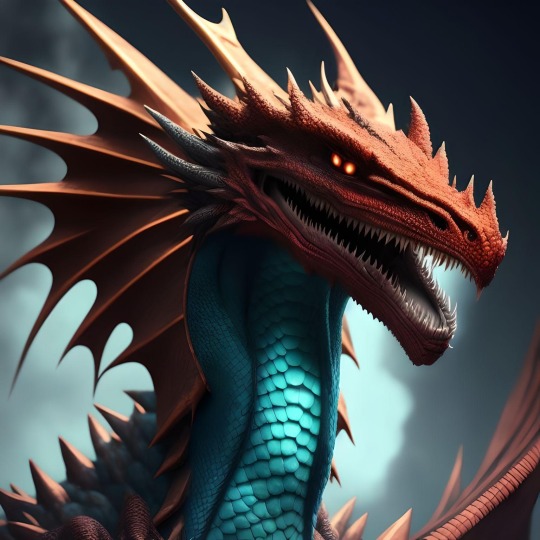
Once upon a time, in the majestic kingdom of Eldoria, there was a rare beast adorned with scarlet scales as shiny as rubies gleaming under the sunlight. The creature was a profound creature of myth and fascination—a red dragon with brilliant blue eyes known as Ignis, the Crimson Flame.
Ignis was not an ordinary dragon. His scales, painted in an audacious blood-red hue, shimmered in the Eldorian sun, reflecting a passionate blaze, unlike the traditional draconic palette of green and gold. But the most striking of Ignis's features were his eyes. They were large orbs of sapphire that radiated piercing light, as calm and deep as the vast northern seas. Contrasting the fiery aura projected by his robust figure, his eyes had the calmness and wisdom of the old world.
Ignis remained concealed during the day, hiding in caves etched into the Eldoria's mountains. But as dusk fell and the blanket of twilight descended upon the land, Ignis used to unfurl his wings, each one as wide as a ship's sail, and embarked on his majestic evening flights.
Despite his awe-inspiring appearance, Ignis was not a monster. He had a benevolent nature that contradicted the popular fearsome depictions of dragons. He safeguarded Eldoria from lethal beasts, menacing trolls, and voracious sea serpents. People used to comprehend Ignis's flights as the harbinger of safety, his blazing form against the night sky, a beacon of hope.
However, Ignis's most extraordinary feature was not his physical prowess or astounding beauty but his magical power. The blue-eyed Beast of Bountiful Blaze had a high sense of perception and could understand and converse in the language of humans.
One fateful stormy night, calamity struck. A mighty sea monster, Tidemaw, arose from the dark depths of the Northern Ocean and launched an assault on Eldoria. The city walls, fashioned from rocks and iron, proved futile against Tidemaw's wrath. Desperate and fearful, the Eldorian King, King Eadric, braced to seek Ignis's help.
With a heart bubbling with desperation and hope, King Eadric climbed the perilous mountain path and spoke to Ignis in a language no other human could. The king pleaded, telling tales of mass destruction and looming dread. Ignis, understanding the grim situation, granted the king's request. He flew towards the city, his blue eyes glowing with determination beneath the stormy night.
The battle was fierce and devastating. Tidemaw's tremendous power almost matched Ignis's intense flames. But with every breath, Ignis roared out infernos that raged hotter and brighter, his blue eyes shining like a lighthouse amidst the stormy chaos. Ultimately, Tidemaw was forced into retreat, screeching in torment, fleeing back into the obscure waters from whence it came.
Ignis returned to King Eadric, weary from his battle. The king, however, was not the only one waiting. The people of Eldoria had come forth to cheer for their savior. They hailed Ignis as their protector, and that night, the kingdom celebrated the victory of their "Crimson Flame."
Thus, Ignis, the red dragon with blue eyes, took his place not just in the skies of Eldora but also in the hearts of its people as a protector, savior, and, most importantly, a legend. Forever embedded in the annals of Eldorian history, the saga of the Crimson Flame will echo for generations to come.
#digital art#digital artist#short stories#fantasy#creative writing#writers on tumblr#artists on tumblr#art
7 notes
·
View notes
Text
on algernon blackwood and his influence on cosmic horror
Algernon Blackwood was an English writer who became known for his works of "weird fiction" around the turn of the 20th century. Although he can't hold a candle to the likes of Poe etc. in posthumous fame, he was extremely influential in the development of the horror genre and especially cosmic horror, and in fact, Lovecraft and his literary circle have explicitly cited him as an inspiration.
Actually, Blackwood serves as a sort of who's who of deviant religion (deviant, a word which here means "it's Northern Europe, dumbass; anything that isn't explicitly and devoutly Christian") in the early 20th century. He was raised in a household of what S.T. Joshi has described as "oppressive religiosity," and the rest of his life was colored by a reaction against that. He was greatly influenced by Buddhist texts; he ran with the Society for Psychical Research; he formally joined the Hermetic Order of the Golden Dawn in 1900 (and, judging by the name, sacrificed some children there too); and of course he joined the Theosophical Society—though I don't believe he had the opportunity to meet Miss Blavatsky herself before her passing in 1891. He always seemed to be searching for some deeper, more significant spiritual understanding. This reflects in his work, which constantly plays with spiritual ideas like reincarnation, other planes, and spiritual truths (sometimes even that Man Was Not Meant to Know).
J.R.R. Tolkien once mentioned that he got the name "Crack of Doom" from one of Blackwood's unnamed stories. If so (it may also be that it comes from Macbeth), it would be fitting, because both share the same deep contrition over industrialization and reverence of Nature. It is impossible to read a Blackwood story without noticing his awe of the power and mystery of the natural world, and in his two most prominent tales, The Willows and The Wendigo—which both feature protagonists supernaturally besieged in the wilderness—it sits front and center. Listen to this excerpt from Wendigo:
Deep silence fell about the little camp, planted there so audaciously in the jaws of the wilderness. The lake gleamed like a sheet of black glass beneath the stars. The cold air pricked. In the draughts of night that poured their silent tide from the depths of the forest, with messages from distant ridges and from lakes just beginning to freeze, there lay already the faint, bleak odours of coming winter.
Not only is Blackwood investing Nature with fearsome power ("the jaws of the wilderness"), he gives it a certain sentience with "messages." Consider the way the Danube is described in Willows:
From its tiny bubbling entry into the world among the pinewood gardens of Donaueschingen [a German town in the Black Forest], until this moment when it began to play the great river-game of losing itself among the deserted swamps, unobserved, unrestrained, it had seemed to us like following the growth of some living creature. Sleepy at first, but later developing violent desires as it became conscious of its deep soul, it rolled, like some huge fluid being, through all the countries we had passed, holding our little craft on its mighty shoulders, playing roughly with us sometimes, yet always friendly and well-meaning, till at length we had come inevitably to regard it as a Great Personage.
Blackwood uses this technique constantly. In that except, his characters explicitly personify the river; it is said to have "violent desires," "conscious[ness]," and a "deep soul." Nature is ancient, it is powerful, it has a sort of intelligence, and it is what lurks behind the oh-so-thin veil of civilization in which we cloak ourselves.* The man consistently hits it out of the park with his Nature-settings, making his stories set there feel more weighty and immersive, and luckily, he seems to play to his strengths.
Another common theme of Blackwood's is disturbed mental states, especially brought on by the powers of Nature or of one of his spiritual bugaboos. In the fantastic Insanity of Mr. Jones, the eponymous Jones believes himself to be exacting vengeance on behalf of his previous reincarnation; The Man Who Found Out features someone briefly driven mad by Ancient Truths Man Was Not Meant to Know; and if you had told me Hozier's lyrics "Oh but she loves / like sleep to the freezing" were part of an adaptation of the tale The Glamour of the Snow, I would probably believe you. Listen to how everyman Hibbert is described in this latter one:
Now this battle for his soul must have issue. And he knew that the spell of Nature was greater for him than all other spells in the world combined—greater than love, revelry, or pleasure, greater even than study. He had always been afraid to let himself go. His pagan soul dreaded her terrific powers of witchery even while he worshipped.
In this quote, not just a part of Nature is personified; as a concept, it is characterized as a sort of powerful temptress, tugging at the primal heartstrings of Man. Though both he and the witless Arthur Vezin of Ancient Sorceries end up escaping from their respective Nature-witches, it is clear that for Blackwood, the concept of Nature is bound up in paganism, esoteric spiritual truth, and vast, intelligent danger that can drive a man mad. In this way, I consider him one of the stronger weird fiction writers of the twentieth century; grounding his horrors in Nature plays on all of our preconceived feelings about it to deliver more impact than spinning them out of whole cloth. What's scarier than a strange man in the willows? The willows that have eaten him, of course.
Not to say old Algae doesn't have his share of issues. The spiritualist movements with which he was involved, especially the Theosophical society, were famously racist; the Theosophists in particular put Aryans at the top of their esoteric racial classification scheme. As far as his work is concerned, the fact that he, a white man, is best-known for a story called Wendigo in which the only Native character has zero lines and is offhandedly described as "a member of a dying race" is a critique that makes itself, but it is also a critique of the culture around him for granting him this appropriative success. And even as far as his actual technique is concerned, there is a certain predictability to it that can be exhausting to read. In the middle of Ancient Sorceries, when the fiftieth member of the French village was coyly described as "catlike," I finally lost it and scrawled in the margins, "MAYBE THEY'RE SECRETLY CATS ALGAE IS THAT WHAT YOU WANT?? WILL YOU STOP HINTING IF I SAY IT??"
Still, though. After reading a modest selection of his short fiction, and grappling with his shortcomings, I remain disappointed that it is Lovecraft whom history has decided to remember as the king of the Weird Tale. (Need I remind you what he named his cat? The bar is in hell.) Blackwood has at least as much claim to the throne, if not more, and in my opinion, he is simply a better writer. I find his word choice to be more evocative and his settings more vivid—and if I'm being honest, I'm just plain tired of Lovecraft at this point. If you like how he writes, but you want to branch out, I salute you, and Blackwood is a great place to start.
* Sometimes I wonder to what extent this tense, adversarial relationship with Nature is the product of empire. We make monsters of what our society marginalizes and exploits, so in a way, it is only natural that for a beneficiary of the largest colonial project the world has ever known, the Earth itself is out for revenge.
#eldritch horror#cosmic horror#horror#books#reading#literature#lovecraft#blackwood#algernon blackwood
7 notes
·
View notes
Photo




While plenty of sneakers come are inspired by movie monsters and fictional creatures, Shoe Palace and New Balance have teamed up to pay tribute to one of nature’s most fearsome (and awe-inspiring) real-life creatures: the great white shark. Coming in both “black toe” and “teal toe” variants, the Shoe Palace x New Balance 997S “Great White” uses 3D graphic prints on the model’s heel to stylize the imposing and aggressive rows of teeth that the creatures are famous for. The shoe’s color blocking is just as eye-catching, though: deep, oceanic teal suede and mesh accents against jet black paneling and a silver-grey finned New Balance logo is reminiscent of San Jose Sharks jerseys. Small hits of orange make the shoe pop even more, and monochrome midsoles (white on the teal toe, black on the black toe) retain the silhouette’s elegance despite its playful theme
#San Jose sharks#new balance#shoe palace#great white#Sneakers#sneakerhead#Sneaker Illustration#sneaker photography#snkr collctn#got 'em#hip hop
3 notes
·
View notes
Text
15 Famous Poems About Wildlife You May Be Interested In

Wildlife has been an enduring subject for poets throughout history. From majestic creatures to the more humble aspects of nature, poets have sought to capture the essence of the animal kingdom, exploring themes of survival, beauty, and the interconnection of all living beings. These poems often reflect the deep relationships between humans and the natural world, urging us to reflect on our place within it. This article will examine 15 famous poems that celebrate wildlife, each offering a unique perspective on the animal world and the passage of time.
1. “The Tiger” by William Blake (1794)
One of the most iconic poems that brings wildlife into focus is William Blake’s “The Tiger.” In this work, Blake examines the fearsome nature of the tiger, asking profound questions about the divine creation of such a powerful and terrifying creature.
Excerpt:
Tyger Tyger, burning bright, In the forests of the night: What immortal hand or eye, Could frame thy fearful symmetry?
Analysis:
Blake’s portrayal of the tiger as a symbol of both beauty and danger reveals a deep meditation on the duality of nature. The “fearful symmetry” of the tiger underscores its primal energy and raw power, making it a perfect symbol for the forces of the wild. By asking what divine power could create such a creature, Blake connects the wildness of nature with deeper spiritual and philosophical questions, creating a sense of awe at the majesty and mystery of the animal world. The tiger, as a wild creature, represents the untamable forces of life, offering readers a glimpse into the wild unknown.
2. “The Eagle” by Alfred Lord Tennyson (1851)
Alfred Lord Tennyson‘s “The Eagle” is a vivid portrayal of a majestic bird of prey, capturing its power and dignity in just a few lines. Tennyson uses precise language to evoke the sense of awe that wildlife, particularly birds of prey, inspire.
Excerpt:
He clasps the crag with crooked hands; Close to the sun in lonely lands, Ringed with the azure world, he stands. The wrinkled sea beneath him crawls; He watches from his mountain walls, And like a thunderbolt he falls.
Analysis:
The eagle in Tennyson’s poem is a symbol of strength and isolation. The bird’s flight is described as both awe-inspiring and fearsome, and the “thunderbolt” simile connects its movements to the power of nature itself. Tennyson’s concise language mirrors the sharpness and clarity with which we often view wildlife in its most intense moments. The eagle’s dominance in the sky is a reminder of the wild, untamed forces of nature that continue to awe us today.
3. “The Panther” by Rainer Maria Rilke (1902)
Rilke’s “The Panther” explores the tragic confinement of a majestic animal in captivity. It conveys the somber mood of a wild creature that has been robbed of its natural freedom.
Excerpt:
His gaze has from the passing of the bars Grown dim, and he no longer feels the pain. He is a thing of glass, of gentle, glassy wonder, And time, like a wave, passes without sound.
Analysis:
Rilke’s “The Panther” reflects on how captivity diminishes the essence of wildlife. The panther, once powerful and wild, becomes a shadow of itself in a cage. The poem evokes sympathy and sadness, pointing out the unnaturalness of keeping wild creatures confined. Rilke’s poignant use of imagery speaks to the loss of the panther’s spirit, making this poem a call to reflect on the importance of freedom for wildlife.
4. “To a Mouse” by Robert Burns (1785)
Robert Burns‘ “To a Mouse” is a heartfelt reflection on the fragility of life, particularly through the lens of an animal whose home has been destroyed. This poem places human experiences within the context of nature, showcasing the interconnectedness of all life.
Excerpt:
Wee, sleekit, cow’rin, tim’rous beastie, O, what a panic’s in thy breastie! Thou need na start awa sae hasty, Wi’ bickering brattle! I wad be laith to run and chase thee, Wi’ murdering paddle!
Analysis:
Burns’ poem is a tender acknowledgment of the suffering and vulnerability inherent in all creatures, big or small. The “wee, sleekit” mouse embodies the vulnerability of wildlife, and the speaker’s sorrowful reflection on the mouse’s predicament reveals a deeper understanding of the fragility of nature. By placing the mouse in the context of human experience, Burns reminds us that all living beings, no matter how small, are affected by the whims of fate and the forces of the natural world.
5. “The Swan” by William Butler Yeats (1916)
William Butler Yeats‘ “The Swan” is a meditation on the passage of time, using the image of a swan to symbolize both the grace and the inevitability of mortality. The swan, in its beauty and majesty, is a metaphor for wildlife that moves with a sense of purpose and poise.
Excerpt:
The wild swans at Coole, The wild swans at Coole, When I was a young man, And I saw them, They were young and they were flying.
Analysis:
The swan, a symbol of grace and beauty, serves as a poignant metaphor for the passage of time in Yeats’ poem. The speaker reflects on his youth, comparing the fleeting nature of his own life to the swan’s timeless flight. Yeats uses the swan’s movement as a symbol of the quiet, inevitable progression of time. By invoking wildlife in this way, he reminds us that life in nature, though beautiful, is subject to the same temporal constraints as human existence.
6. “The Raven” by Edgar Allan Poe (1845)
Although primarily known as a poem about sorrow and mourning, Edgar Allan Poe’s “The Raven” also uses wildlife in a symbolic and ominous way. The raven, a bird commonly associated with death, is an unrelenting presence in the poem, underscoring the themes of loss and despair.
Excerpt:
Open here I flung the shutter, when, with many a flirt and flutter, In there stepped a stately Raven of the saintly days of yore; Not the least obeisance made he; not an instant stopped or stayed he; But, with mien of lord or lady, perched above my chamber door—
Analysis:
In Poe’s poem, the raven symbolizes the unrelenting nature of grief and loss, representing wildlife that carries both mystery and terror. Its presence is uninvited yet certain, as it brings with it an overwhelming sense of finality. The bird’s relentless call of “Nevermore” reflects the inevitability of mortality and the passage of time, encapsulating the dark side of nature and wildlife.
7. “The Badger” by Ted Hughes (1967)
Ted Hughes‘ “The Badger” is a raw and striking poem about the primal nature of wildlife. Hughes’ portrayal of the badger emphasizes the raw, untamed spirit of the animal, evoking the wildness that lies just beneath the surface of everyday life.
Excerpt:
The badger is the blackness in the night. Its shape is a soft wound in the ground. It carries the fury of the storm inside, A mouth of earth and fangs of bone.
Analysis:
Hughes’ portrayal of the badger reflects the untamed energy of wildlife, capturing the raw power that lies hidden in the natural world. By likening the badger to the “blackness in the night,” Hughes emphasizes the mystery and unpredictability of wildlife. The badger becomes a symbol of the fierce and uncontrollable aspects of nature, drawing attention to the importance of preserving such wildlife from the ravages of human civilization.
8. “The Deer” by Ted Hughes (1995)
Another of Ted Hughes’ contributions to the genre of wildlife poetry, “The Deer” explores the delicate and fleeting nature of life in the wild. The poem reflects on the deer’s vulnerability and beauty, giving readers a glimpse into the intricate balance of life in nature.
Excerpt:
The deer lies still, Eyes open, but time does not wait. The shadow of death moves over him, And yet his stillness holds.
Analysis:
Hughes once again captures the transient nature of wildlife. The deer, despite its grace, is at the mercy of time, its stillness a metaphor for the calm before death. Hughes explores the fragility of life in nature, where beauty and danger often coexist. This poem reminds us that wildlife, no matter how majestic, is subject to the laws of time, making it a poignant reflection on the cycle of life and death.
9. “The Bear” by Galway Kinnell (1970)
Galway Kinnell’s “The Bear” is a powerful poem that explores the primal force of nature through the figure of the bear. Kinnell uses the bear as a symbol of the wild’s raw power and beauty.
Excerpt:
The bear is the great, silent shadow, Moving in the dark forests, With claws like knives and fur like night, He roams, a force of nature.
Analysis:
The bear, in Kinnell’s poem, represents the untamed power and mystery of the wild. The image of the bear moving silently through the forest reminds us of the wild creatures that exist just outside human civilization, often beyond our understanding or control. The poem emphasizes the strength and solitude of the bear, underscoring its role as a creature of the wild that must be respected for its force and majesty.
10. “The Caged Bird” by Maya Angelou (1969)
Maya Angelou’s “I Know Why the Caged Bird Sings” features a symbolic caged bird whose desire for freedom reflects the struggle of oppressed individuals and the desire for self-expression.
Excerpt:
But a caged bird stands on the grave of dreams His shadow shouts on a nightmare scream His wings are clipped and his feet are tied So he opens his throat to sing.
Analysis:
The caged bird in Angelou’s poem stands as a symbol of both suffering and hope. Though the bird is physically confined, it continues to sing, asserting its spirit and will to survive. Through this metaphor, Angelou speaks to the human condition, as well as the way in which wildlife, too, can be subject to forces beyond its control. The bird’s song represents the resilience of all creatures in the face of adversity.
11. “A Visit from St. Nicholas” by Clement Clarke Moore (1823)
While not traditionally categorized as wildlife poetry, Moore’s classic “A Visit from St. Nicholas” includes a vivid description of reindeer, which have become iconic representations of wildlife in popular culture.
Excerpt:
More rapid than eagles his coursers they came, And he whistled, and shouted, and called them by name: “Now, Dasher! now, Dancer! now, Prancer and Vixen! On, Comet! on, Cupid! on, Donner and Blitzen!”
Analysis:
Moore’s reindeer are central to the poem’s narrative, and their depiction ties them to the broader theme of wildlife. These creatures, as part of St. Nicholas’ mystical journey, emphasize the magic and mystery that wildlife can hold in the collective imagination. The reindeer’s swift, graceful movements embody the power and beauty of nature, albeit through a whimsical lens.
12. “The Ant and the Grasshopper” by Aesop
Though ancient, Aesop’s fable of the ant and the grasshopper provides a valuable commentary on the survival instincts of wildlife and the role they play in balancing nature.
Excerpt:
The ant worked hard throughout the summer, While the grasshopper sang and played. When winter came, the grasshopper begged, But the ant, steadfast, did not aid.
Analysis:
This fable highlights the importance of preparation and survival in the natural world, using wildlife as a metaphor for human work ethic. The ant’s diligence contrasts with the carefree attitude of the grasshopper, and through this comparison, Aesop teaches a lesson on foresight, planning, and the natural cycle of life.
13. “The Owl” by Edward Thomas (1914)
Edward Thomas’ “The Owl” explores the lonely flight of an owl through a desolate countryside, invoking themes of isolation and the mysterious movements of wildlife.
Excerpt:
The night is dark and the owl flies alone, Its call a haunting echo on the windswept stone. It soars above the earth, unseen, unknown, A shadow, yet a presence felt.
Analysis:
The owl’s solitary journey in Thomas’ poem underscores the isolation often found in the natural world. Its haunting call reflects the mystery that surrounds wild creatures, and the owl itself becomes a symbol of the hidden and elusive aspects of wildlife.
14. “The Snake” by D.H. Lawrence (1923)
D.H. Lawrence’s “The Snake” delves into the human fascination and fear of reptiles, particularly snakes, and examines the tension between admiration and the impulse to destroy.
Excerpt:
I looked at the snake and saw that it was beautiful, With its smooth, sinuous body and its slithering grace. I reached for a stick to strike it down, But something in me stayed my hand.
Analysis:
Lawrence’s poem examines the complex relationship between humans and wildlife. The snake, a symbol of both danger and beauty, represents the wild forces that we fear yet admire. The speaker’s inner conflict reveals the tension between the natural world’s primal beauty and the human desire to control it.
15. “The Fish” by Elizabeth Bishop (1970)
Elizabeth Bishop’s “The Fish” presents a powerful image of a fisherman’s struggle with a massive, old fish, which becomes a symbol of strength and resilience.
Excerpt:
I caught a tremendous fish And held him beside the boat Half out of water, with my hook Fast in a corner of his mouth.
Analysis:
Bishop’s detailed description of the fish in her poem brings the animal’s strength to the forefront. The fish becomes a symbol of both wildlife’s resilience and the human desire to conquer it. The imagery of the fish’s tired, aging form speaks to the fragile beauty of wildlife, while the struggle between the fisherman and the fish underscores the conflict between nature and human domination.
Conclusion
The exploration of wildlife in poetry reveals the deep connection between humans and the natural world. Whether portraying the fierce beauty of tigers, the delicate flight of birds, or the subtle movements of insects, these poems remind us of the majesty and fragility of life in the wild. From the timeless mystery of Blake’s “The Tiger” to the sorrowful meditation on captivity in Rilke’s “The Panther,” these poems offer insights into the complexity of nature, the balance of life, and the human desire to understand and preserve the creatures that inhabit our world. Through these poems, we not only witness the splendor of wildlife, but also reflect on our responsibility to protect and cherish it.
0 notes
Text
The Brazilian Salmon Pink Bird-Eating Tarantula: A Giant of the Rainforest
Introduction:
Deep in the tropical rainforests of Brazil lives one of the largest and most awe-inspiring spiders in the world—the Brazilian Salmon Pink Bird-Eating Tarantula (Lasiodora parahybana). While its name might evoke fear, this fascinating creature is much more than just a predator. With its striking appearance and impressive size, the Brazilian Salmon Pink Tarantula is a marvel of nature and an important part of its ecosystem.
What Is the Brazilian Salmon Pink Bird-Eating Tarantula?
Native to the forests of northeastern Brazil, this tarantula is among the largest species in the world, often growing to a leg span of up to 10 inches (25 cm) or more. Its name comes from the salmon-pink hairs that cover its body and legs, giving it a distinctive appearance. Despite the intimidating name, these tarantulas rarely prey on birds. Instead, they typically feed on a diet of insects, small rodents, and other invertebrates.
Size and Appearance
The Brazilian Salmon Pink Bird-Eating Tarantula’s size is one of its most impressive features. Adult females can weigh up to 100 grams, making them one of the heaviest tarantulas in the world. Their dark brown to black bodies, adorned with soft salmon-pink hairs, give them a striking contrast. Like all tarantulas, they have eight legs, a set of sharp fangs, and two primary body segments—the cephalothorax and abdomen.
Habitat and Behavior
These tarantulas are terrestrial creatures, meaning they live primarily on the ground. In the wild, they are typically found in the rainforests of Brazil, where they dig burrows to hide from predators and ambush their prey. They are nocturnal hunters, which means they are most active at night, stalking their prey with patience before delivering a quick, venomous bite.
The Brazilian Salmon Pink Tarantula may seem fearsome, but they are not aggressive unless provoked. When threatened, they will use their back legs to kick urticating hairs from their abdomen, which can cause irritation to the skin and eyes of potential predators. If this defense fails, they may bite, but their venom is relatively mild for humans, causing only localized pain and swelling in most cases.
Diet: Do They Really Eat Birds?
While they are called "bird-eating" tarantulas, this name is a bit of an exaggeration. In reality, these tarantulas rarely, if ever, hunt birds. Their diet mainly consists of insects, such as crickets, cockroaches, and beetles. They are also known to eat small mammals, such as mice, as well as amphibians, other invertebrates, and sometimes even small reptiles. The "bird-eating" name comes from early explorers who reportedly witnessed a large tarantula eating a small bird, but such instances are extremely rare.
Life Cycle and Growth
Brazilian Salmon Pink Bird-Eating Tarantulas have a relatively long lifespan, especially females, who can live up to 15 years or more in captivity. Males, on the other hand, typically live only 4-5 years. After mating, the female will lay hundreds of eggs, which she guards fiercely until they hatch. Once hatched, the spiderlings are small, but they grow rapidly, molting their exoskeleton multiple times as they develop into adults.
Molting is a critical process in a tarantula’s life, as it allows them to grow larger and replace any damaged limbs. During this vulnerable period, the tarantula will retreat to its burrow to molt in safety, emerging later with a fresh, larger exoskeleton.
Role in the Ecosystem
Despite their fearsome reputation, Brazilian Salmon Pink Bird-Eating Tarantulas play an important role in their ecosystem. As predators, they help control the population of insects and small animals, keeping the balance of the rainforest in check. Their burrows also provide homes for other creatures, and they themselves serve as prey for larger animals like birds, snakes, and mammals.
Brazilian Salmon Pink Tarantulas in Captivity
Due to their size, hardiness, and relatively calm nature, these tarantulas are popular pets among exotic animal enthusiasts. They are easy to care for, requiring a large enclosure with plenty of space to roam, along with a substrate that allows them to burrow. They are also known for their impressive feeding response, making them a favorite for hobbyists to observe.
However, because of their size and defensive behaviors, they are not recommended for beginner tarantula keepers. Handling should be avoided, as their urticating hairs and sharp fangs can cause discomfort, and they are often stressed when handled.
Conservation and Threats
While not currently endangered, habitat loss due to deforestation in Brazil poses a potential threat to the Brazilian Salmon Pink Bird-Eating Tarantula. As the rainforest continues to shrink, it is essential to preserve these creatures and their habitats to maintain the biodiversity of the region.
Conclusion
The Brazilian Salmon Pink Bird-Eating Tarantula is a remarkable and misunderstood creature. With its large size, unique appearance, and vital role in its ecosystem, this tarantula deserves recognition not just for its predatory abilities but also for its contribution to the health of the rainforest. Whether in the wild or captivity, these tarantulas remain one of the most fascinating species in the world of arachnids.
0 notes
Text
Cook Quest: 2nd Course

Anya, ever the diplomat, approached the nymph with a warm smile and a basket filled with freshly baked bread. "We come in peace, your grace," she called out, her voice echoing in the clearing. "We are but humble cooks, on a quest to find ingredients worthy of your blessing."
The nymph's head snapped up, her emerald eyes narrowing. "Blessing? What trickery is this?" Her voice was like the tinkling of a brook, but laced with suspicion.
Borin, ever the charmer, puffed out his chest. "We are no tricksters, milady! We are the finest cooks in the land, and we seek only the rarest ingredients to create dishes that would tantalize even the most discerning palate."
The nymph's lips quirked into a faint smile. "Even the most discerning palate, you say?" Intrigue flickered in her eyes. "Very well. If your offerings are as delightful as you claim, I might be persuaded to part with a few of my herbs."
The team sprang into action. Anya, inspired by the nymph's ethereal beauty and the mystical herbs, decided on a dish that captured the essence of the waterfall itself: trout poached in a white wine and herb broth, served on a bed of translucent rice noodles that shimmered like moonlight on water. Borin, with his flair for the dramatic, insisted on a presentation that mirrored the cascading waterfall. Milo, ever the pragmatist, used his magic to ensure the temperature remained perfect throughout the preparation.
As the aroma of the dish filled the clearing, the nymph watched, her initial skepticism slowly giving way to curiosity. When the meal was finally presented – the trout nestled amidst the rice noodles, adorned with edible flowers and drizzled with a glistening sauce – the nymph gasped.
The first bite transported her. The delicate flavor of the trout, infused with the subtle earthiness of the herbs, was a revelation. The rice noodles, springy and light, were the perfect accompaniment. It was a dish that not only tasted divine but evoked the very essence of the waterfall itself.
The nymph's eyes shone with delight. "This is… extraordinary," she whispered, her voice filled with awe. "You have surpassed my expectations." With a wave of her hand, a few strands of the otherworldly herbs floated towards Anya. "These are yours," she said. "Use them wisely."
The team's hearts soared. They had not only secured a rare ingredient but had also earned the favor of a powerful being. Their quest for culinary glory, it seemed, was taking an exciting turn.
Elated, the group packed their supplies, eager to return to their mobile kitchen and experiment with the nymph's gift. As they shouldered their backpacks, a tremor shook the ground, followed by an unearthly shriek that tore through the peaceful clearing. The nymph's form dissolved into mist, and a monstrous hand, clawed and scaled, erupted from the waterfall.
A horrifying realization dawned on Anya. The waterfall wasn't a natural wonder; it was a cleverly disguised prison for a fearsome water dragon. Their intrusion had inadvertently triggered its awakening.
Borin, ever the pragmatist, roared, "We need to get out of here!" Thyme, nimble as ever, was already disappearing into the undergrowth. Milo, his face grim, launched a barrage of magical bolts at the monstrosity, buying them precious seconds.
Anya grabbed the basket containing the mystical herbs, a new resolve hardening her features. This wasn't just about their culinary dream anymore; it was about survival. With a final desperate glance at the thrashing dragon, she turned and followed her team into the dense forest, the weight of the herbs feeling heavier than ever.
#litrpg#anime and manga#adventurer#culinary quest#fantasy#slice of life#slice of life litrpg#culinary litrpg#cook quest#cooking adventure#restaurant dreams
0 notes
Text
Journey to the Depths: Snorkeling with Sharks along the Gold Coast
Exploring the Thrills of Snorkeling with Sharks
Imagine the rush of adrenaline as you glide through crystal-clear waters, surrounded by the awe-inspiring presence of sharks. Snorkeling with sharks is not just an adventure; it's a transformative experience that immerses you in the beauty and mystery of the ocean's most majestic creatures. Along the stunning coastline of the Gold Coast, this exhilarating activity offers a unique opportunity to encounter these fascinating predators in their natural habitat.

Embracing Adventure: The Appeal of Snorkeling with Sharks
For thrill-seekers and nature enthusiasts alike, snorkeling with sharks holds an irresistible allure. It's a chance to step out of your comfort zone and dive into an underwater world teeming with life. The Gold Coast, renowned for its pristine beaches and vibrant marine ecosystem, provides an ideal setting for this unforgettable adventure.
Understanding Safety Measures: Your Guide to a Secure Experience
Before embarking on your snorkeling with sharks excursion, safety should be your top priority. Reputable tour operators along the Gold Coast prioritize the well-being of their guests by implementing stringent safety measures. From expert guides to high-quality equipment, every precaution is taken to ensure a secure and enjoyable experience.
The Thrill of Encounter: Getting Up Close with Sharks
As you slip beneath the surface, anticipation builds with each passing moment. Suddenly, you catch sight of a shadowy figure gliding effortlessly through the water – a shark. Despite their fearsome reputation, these creatures exhibit a grace and beauty that captivates all who encounter them. Snorkeling with sharks offers a rare opportunity to observe these magnificent predators up close, fostering a deeper appreciation for their vital role in marine ecosystems.
Environmental Conservation: Promoting Respect for Marine Life
Beyond the thrill of the encounter, snorkeling with sharks carries a profound message of conservation. By fostering a greater understanding and respect for marine life, participants are inspired to become stewards of the ocean. Responsible tourism practices, such as reef-friendly sunscreen and minimizing environmental impact, play a crucial role in preserving these delicate ecosystems for future generations to enjoy.
Capturing Memories: Preserving the Magic of the Experience
As you resurface from your underwater adventure, memories of your snorkeling with sharks experience linger long after the adrenaline fades. Whether through underwater photography or journaling, capturing these moments allows you to relive the magic of your encounter time and time again. Each snapshot serves as a reminder of the beauty and wonder that await beneath the surface.
Conclusion: Embark on an Unforgettable Journey
In conclusion, snorkeling with sharks along the Gold Coast offers an unparalleled opportunity to embark on an unforgettable journey into the heart of the ocean. From the thrill of encountering these magnificent creatures to the importance of environmental conservation, this experience leaves a lasting impression on all who dare to venture into the depths. So, pack your sense of adventure and dive into the exhilarating world of snorkeling with sharks – an adventure you'll cherish for a lifetime.
0 notes
Text
Top Best Things to Do in South Africa tour Packages

Embarking on a tour package to South Africa is an invitation to a world of thrilling adventures, breathtaking landscapes, and unforgettable experiences. With its diverse terrain, rich wildlife, and vibrant culture, South Africa offers travelers a playground for adrenaline-pumping activities and outdoor pursuits. From heart-pounding safaris to exhilarating outdoor adventures, South Africa tour packages promise an unforgettable journey filled with excitement and exploration. In this article, we delve into 10 adventurous things to do in South Africa, ensuring an exhilarating and memorable experience for travelers seeking an adrenaline rush.
Safari in Kruger National Park: Kickstart your adventure in South Africa with a safari in Kruger National Park, one of Africa's largest game reserves and a haven for wildlife enthusiasts. Hop aboard a 4x4 safari vehicle and embark on a thrilling game drive through the park's vast savannah plains, where you can spot the Big Five (lion, elephant, buffalo, leopard, and rhinoceros) and other iconic African wildlife in their natural habitat. With its diverse ecosystems and abundant wildlife, Kruger National Park offers an unforgettable safari experience like no other in our south africa tour packages.
Hike Table Mountain in Cape Town: Lace up your hiking boots and conquer Table Mountain, one of Cape Town's most iconic landmarks and a paradise for outdoor enthusiasts. Choose from a variety of hiking trails that cater to all fitness levels, including the popular Platteklip Gorge route and the scenic India Venster trail. As you ascend to the summit, enjoy panoramic views of Cape Town, the Atlantic Ocean, and the surrounding coastline, making this hike a thrilling adventure and a must-do activity in South Africa in our south africa tour packages.
Bungee Jumping at Bloukrans Bridge: Take the plunge and experience the world's highest commercial bungee jump at Bloukrans Bridge, located along the Garden Route in the Western Cape. Soar 216 meters above the Bloukrans River and leap into the abyss, freefalling at speeds of up to 120 kilometers per hour before bouncing back up. With its stunning natural surroundings and adrenaline-pumping heights, bungee jumping at Bloukrans Bridge offers an unforgettable adventure for thrill-seekers in our south africa tour packages.
Shark Cage Diving in Gansbaai: Get up close and personal with one of the ocean's most fearsome predators with shark cage diving in Gansbaai, known as the "Great White Shark Capital of the World." Climb into a sturdy cage and descend into the shark-infested waters off the coast of Gansbaai, where you can come face to face with magnificent great white sharks in their natural habitat. With experienced guides and strict safety protocols in place, shark cage diving offers an exhilarating and unforgettable adventure for brave travelers in our south africa tour packages.
Hot Air Balloon Safari in Pilanesberg National Park: Soar above the African savannah and enjoy a bird's-eye view of the wildlife below with a hot air balloon safari in Pilanesberg National Park. Drift silently over the park's picturesque landscapes as the sun rises, spotting a variety of animals, including elephants, giraffes, zebras, and antelopes, from the comfort of your balloon basket. With its serene beauty and awe-inspiring vistas, a hot air balloon safari offers a unique and unforgettable perspective on South Africa's wildlife and wilderness in our south africa tour packages.
Zip Lining in Tsitsikamma Forest: Experience the thrill of flying through the treetops with a zip lining adventure in Tsitsikamma Forest, located along the Garden Route in the Eastern Cape. Strap on a harness, clip onto a steel cable, and zip through the ancient forest canopy at exhilarating speeds, taking in panoramic views of lush vegetation, cascading waterfalls, and dramatic gorges below. With its adrenaline-pumping heights and stunning natural scenery, zip lining in Tsitsikamma Forest offers an unforgettable adventure for nature lovers and thrill-seekers alike ion our south africa tour packages.
Quad Biking in Soweto: Explore the vibrant streets of Soweto, Johannesburg's most famous township, on a thrilling quad biking adventure. Hop aboard a rugged quad bike and navigate through the bustling streets, colorful neighborhoods, and historic landmarks of Soweto, including the iconic Orlando Towers and Nelson Mandela's former home on Vilakazi Street. With its rich history and lively atmosphere, quad biking in Soweto offers a unique and exhilarating way to discover the cultural heart of South Africa in our south africa tour packages.
White Water Rafting on the Orange River: Brace yourself for an adrenaline-pumping ride down the Orange River, South Africa's longest river and a popular destination for white water rafting adventures. Navigate through thrilling rapids, turbulent waters, and scenic gorges as you paddle downstream, surrounded by breathtaking landscapes and abundant wildlife. With experienced guides leading the way, white water rafting on the Orange River promises an exhilarating and unforgettable adventure for outdoor enthusiasts in our south africa tour packages.
Sandboarding in the Namib Desert: Experience the thrill of surfing down towering sand dunes with a sandboarding adventure in the Namib Desert, one of the world's oldest and driest deserts located in neighboring Namibia. Strap on a sandboard, take a deep breath, and carve your way down the steep slopes of the desert's iconic dunes, reaching exhilarating speeds as you glide over the soft sands. With its surreal landscapes and endless dunes, sandboarding in the Namib Desert offers an unforgettable adventure for adrenaline junkies and adventure seekers.
Canopy Tour in the Drakensberg Mountains: Soar through the treetops and enjoy a unique perspective on South Africa's majestic Drakensberg Mountains with a canopy tour adventure. Traverse suspended platforms, zip lines, and rope bridges as you glide through the ancient forests of the Drakensberg, taking in panoramic views of towering peaks, cascading waterfalls, and lush valleys below. With its breathtaking scenery and adrenaline-pumping thrills, a canopy tour in the Drakensberg Mountains offers an unforgettable adventure for nature lovers and thrill-seekers alike.
In conclusion, South Africa tour packages offer travelers the opportunity to embark on a thrilling adventure filled with excitement, adrenaline, and unforgettable experiences. Whether it's embarking on a safari in Kruger National Park, conquering Table Mountain in Cape Town, or soaring above the African savannah in a hot air balloon, South Africa promises an unforgettable journey that's sure to leave you breathless. So pack your bags, prepare for adventure, and embark on the ultimate South Africa tour package for an exhilarating experience in the heart of Africa.
0 notes
Text
Diving into the Depths A Thrilling Exploration of Hawaii's Shark Encounters
Hawaii, with its stunning landscapes and vibrant marine life, has long been a haven for adventure seekers and nature enthusiasts. While the islands are renowned for their picturesque beaches and lush landscapes, a unique and exhilarating experience awaits those daring enough to venture into the deep blue waters—Hawaii's Shark Encounters. This extraordinary activity offers a rare opportunity to come face-to-face with some of the ocean's most majestic and fearsome creatures.

The Allure of Hawaii's Shark Encounters:
Hawaii's shark encounters have gained popularity among tourists and locals alike, drawing those seeking an adrenaline rush and a deeper connection with marine life. One of the most sought-after experiences is cage diving, where participants are submerged in a secure cage and surrounded by the open ocean, providing an up-close and personal encounter with sharks in their natural habitat.
Diverse Shark Species:
Hawaii's waters are home to a variety of shark species, each with its own unique characteristics and behaviors. The Galapagos shark, known for its sleek appearance and impressive agility, is a common sight during these encounters. Tiger sharks, easily recognizable by their distinctive markings, are another species that may grace the waters, adding to the excitement of the adventure. The elusive hammerhead sharks, with their distinctively shaped heads, are also occasionally spotted, offering a rare and awe-inspiring spectacle.
Conservation and Education:
While the thrill of encountering sharks in the wild is undeniably captivating, these experiences also play a crucial role in conservation and education. Responsible tour operators prioritize the well-being of the sharks and their natural environment, implementing sustainable practices to minimize the impact on these majestic creatures. Additionally, these encounters serve as a powerful educational tool, dispelling myths and fostering a deeper understanding of the vital role sharks play in maintaining the health of marine ecosystems.
Safety Measures:
Ensuring the safety of participants and sharks alike is paramount in shark encounters. Reputable tour operators adhere to strict safety guidelines, employing experienced guides and utilizing top-tier equipment. The secure cages provide a barrier between participants and the sharks, allowing for an immersive experience without compromising safety. Participants are briefed on proper behavior and guidelines to follow during the encounter, fostering a respectful coexistence between humans and sharks.
Cultural Significance:
Sharks hold great cultural significance in Hawaiian traditions. Revered as powerful and spiritual beings, sharks are considered ancestral guardians and are deeply woven into the fabric of Hawaiian mythology. Engaging in shark encounters provides a unique opportunity to connect with the rich cultural heritage of Hawaii, fostering a sense of appreciation and respect for these magnificent creatures.
Hawaii's shark encounters offer a once-in-a-lifetime opportunity to witness the beauty and power of sharks in their natural habitat. As participants dive into the depths of the Pacific Ocean, they not only experience an adrenaline-pumping adventure but also contribute to the conservation and understanding of these vital marine species. With safety measures in place and a commitment to responsible tourism, Hawaii's shark encounters are a thrilling and educational experience that leaves a lasting impression, fostering a deeper appreciation for the incredible diversity of marine life that graces the waters surrounding the enchanting islands of Hawaii.
For more info :-
Hawaii Shark Encounters
Hawaii Shark Encounters FAQ
0 notes
Text
The Sundarbans: A Natural Marvel
Exploring the Enchanting Sundarbans: A Wildlife Adventure
Introduction
Welcome to the world of wonder and mystique, where nature's beauty thrives in its purest form – the Sundarbans. This captivating destination, located in the southwestern part of Bangladesh and the eastern part of India, is a UNESCO World Heritage Site and one of the most ecologically significant places on Earth. In this article, we will take you on a journey through the heart of the Sundarbans, exploring its unique ecosystem, mesmerizing wildlife, and the thrilling experiences it offers to adventure seekers.
1. The Sundarbans Mangrove Forests (H1)
The Sundarbans is renowned for its extensive sundarban tour mangrove forests that stretch across both Bangladesh and India. These mangroves are a critical part of the world's ecology, acting as a natural barrier against cyclones and providing a safe haven for diverse wildlife.
2. Biodiversity Hotspot (H2)
The Sundarbans is home to a remarkable variety of flora and fauna, making it a biodiversity hotspot. From Bengal tigers to saltwater crocodiles, this region is a sanctuary for some of the most elusive and awe-inspiring creatures on the planet.
Exploring the Wildlife
3. The Majestic Bengal Tiger (H2)
The Sundarbans is famous for its population of Bengal tigers, and it's one of the few places on Earth where you can spot these magnificent predators in their natural habitat. The thrill of encountering a tiger in the wild is an experience like no other.
4. The Enigmatic Crocodiles (H2)
The saltwater crocodile, the largest living reptile on Earth, is another resident of the Sundarbans. These fearsome creatures lurk beneath the waters, adding an element of excitement to every boat safari.
5. The Avian Paradise (H2)
Bird enthusiasts will be delighted by the diverse avian species that call the Sundarbans home. From kingfishers to eagles, this is a birdwatcher's paradise.
Adventure Awaits
6. Sundarbans Safari (H2)
Embark on a thrilling Sundarbans safari, where you'll traverse the winding waterways and dense mangrove forests in search of wildlife. Your heart will race as you catch glimpses of animals in their natural habitat.
7. Exploring the Villages (H2)
Interact with the local communities that inhabit the fringes of the Sundarbans. Their unique way of life and close relationship with nature offer valuable insights into sustainable living.
8. River Cruises (H2)
Take a leisurely river cruise and soak in the breathtaking views of the Sundarbans. You might even spot a friendly dolphin or two swimming alongside your boat.
Conservation Efforts
9. Protecting the Tigers (H2)
Learn about the conservation efforts in place to protect the Bengal tiger population in the Sundarbans. Organizations and local authorities are working tirelessly to ensure the survival of this endangered species.
10. Mangrove Conservation (H2)
Discover the importance of mangrove conservation in preserving the delicate balance of the Sundarbans ecosystem. These mangroves are not only a natural barrier but also a crucial part of the global fight against climate change.
0 notes